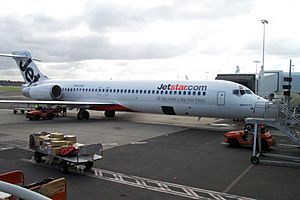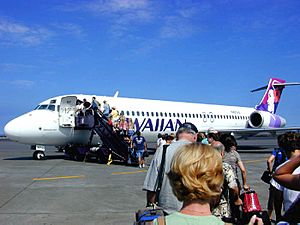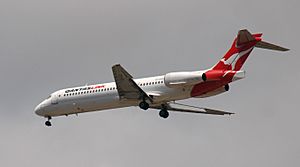Boeing 717 facts for kids
Quick facts for kids Boeing 717 |
|
|---|---|
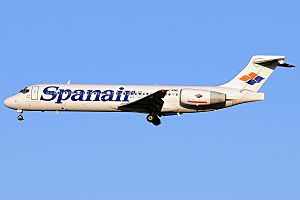 |
|
| A Spanair 717 | |
| Role | Airliner |
| National origin | United States |
| Manufacturer | Boeing Commercial Airplanes |
| Designer | McDonnell Douglas |
| First flight | September 2, 1998 |
| Introduction | October 12, 1999 with AirTran Airways |
| Status | Not being made anymore, but still being used by airlines |
| Primary users | AirTran Airways Hawaiian Airlines Cobham Volotea |
| Produced | 1998–2006 |
| Number built | 156 |
| Developed from | McDonnell Douglas MD-80 |
The Boeing 717 is a type of jet airplane. It has two engines, so it's called a twinjet. It's also a 'narrow-body' plane, meaning it usually has two rows of seats inside. This plane was first designed by McDonnell Douglas and was going to be called the MD-95. It was based on an older plane, the DC-9. The 717 can carry up to 117 passengers. It can fly for about 3,815 kilometers (2,060 nautical miles). The engines are made by Rolls-Royce and are called BR715 turbofan engines.
The first order for this plane came in October 1995. Before the first MD-95 was built, Boeing bought McDonnell Douglas in 1997. The first plane was finished in 1999, and it was named the Boeing 717. Boeing stopped making 717s in May 2006. In total, 156 of these planes were built.
Contents
How the Boeing 717 Was Developed
The DC-9 Family of Planes
Douglas Aircraft started making the DC-9 in the early 1960s. It was designed to fly alongside their bigger DC-8 plane. The DC-9 was a completely new design. It had two Pratt & Whitney JT8D turbofan engines at the back. It also had a smaller wing.
The DC-9 first flew in 1965. Airlines began to use it later that same year. A lot of DC-9s were made, about 976 in total.
Later, the McDonnell Douglas MD-80 series came out in 1980. This was the second group of planes based on the DC-9. The MD-80 was longer than the DC-9-50. It could also carry more fuel and had new engines. Almost 1,200 MD-80s were built between 1980 and 1999.
The MD-90 was designed from the MD-80 series. It first flew in 1993. The MD-90 was even longer and had a modern glass cockpit. It also used new IAE V2525-D5 engines. Only 117 MD-90s were made.
The MD-95 Idea
In early 1994, McDonnell Douglas started designing the MD-95. This plane was planned to be about 36.3 meters (119 feet 4 inches) long. Its wingspan was about 28.5 meters (93 feet 5 inches). McDonnell Douglas thought the MD-95 would become a whole family of different planes.
The MD-95 was made to take the place of the older DC-9. The MD-95 had new engines and a modern cockpit. It was designed to be much more up-to-date.
In March 1995, Scandinavian Airlines System (SAS) chose to buy the Boeing 737-600 instead of the MD-95. Then, in October 1995, ValuJet ordered 50 MD-95s. McDonnell Douglas decided this small order was enough to start making the plane. For two years, the ValuJet order was the only one for the MD-95.
Choosing the Engines
The MD-95 was first planned to use a type of JT8D-200 engine. It could also have used the Rolls-Royce Tay 670 engine. McDonnell Douglas said the MD-95 would be cheap to build. This was because it was so similar to the MD-90.
However, McDonnell Douglas decided that the BMW Rolls-Royce BR700 engine was the best choice. So, on February 23, 1994, this engine was officially picked for the plane.
Where the Planes Were Made
McDonnell Douglas first planned to build all MD-95s in China. But in 1994, they started looking for other places to build the planes cheaply. The Halla Group in South Korea was chosen to make the wings. Alenia of Italy made the main body (fuselage). Aerospace Industrial Development Corp. of Taiwan made the tail. A part of Korea Air Lines made the nose and cockpit.
The Name Change to Boeing 717
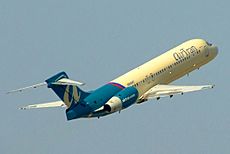
After Boeing bought McDonnell Douglas in August 1997, many people thought Boeing would stop making the MD-95. But Boeing decided to keep building it. They just changed its name to the Boeing 717. There was an old United States Air Force plane called the "717-100." The new airliner was called the "717-200." Since the "717" name wasn't widely used, it was available for this new plane.
At first, Boeing didn't sell many 717s. The first Boeing 717s began to be made in May 1997.
A small Australian airline bought many 717s. This airline later joined with Qantas. This meant Qantas ended up with some 717s they didn't originally want.
However, Qantas soon realized the 717 was quite good. It was bigger and faster than the BAe 146 planes Qantas was using at the time. It was also cheaper to operate. Many airlines that used the 717s, including Qantas, started buying more. Qantas bought more 717s, and so did Hawaiian Airlines and Midwest Airlines.
The main planes that competed with the 717 were the Airbus A318 and the Embraer E-195.
When Production Ended
In December 2003, Boeing lost a big contract worth US$2.7 billion from Air Canada. Air Canada chose to buy Embraer E-Jets and Bombardier CRJ planes instead of the 717. In January 2005, Boeing announced they would stop making the 717 after the last planes were built.
The very last 717 was finished in April 2006 for AirTran Airways. AirTran received both the first and the last 717s ever made. The last two Boeing 717s were for AirTran and Midwest Airlines. They were delivered on May 23, 2006. The 717 was the last airliner built at Boeing's Long Beach factory in California.
Design Features of the Boeing 717

The 717 has a modern glass cockpit. This cockpit design is called the Advanced Common Flightdeck (ACF). The MD-11 plane uses the same type of cockpit.
The 717 can perform special landings called Category IIIb ILS landings. Pilots who are trained to fly the DC-9 can also fly the 717. This is because both planes have the same type rating.
Unlike some other planes, the 717 does not have airstairs at the back. This was done to help the plane use less fuel.
Different Types of Boeing 717
In 1993, McDonnell Douglas planned to make three main types of the 717 (then called MD-95):
- MD-95-30: This was the first and standard type of the plane.
- MD-95-30ER: This version could fly for longer distances and carry more fuel.
- MD-95-50: This type was a bit bigger and could carry more passengers.
Boeing 717 Business Express
The Boeing 717 Business Express would have been a special version of the 717-200. It was designed to be used as a private jet. This version was part of the BBJ (Boeing Business Jet) family.
Types That Were Not Built
Boeing 717-100 (-100X): This was planned to be a smaller version with 86 seats. However, it was cancelled in 2003.
Boeing 717-100X Lite: An even smaller version with 75 seats. It would have used Rolls-Royce Deutschland BR 710 engines. This plan was also cancelled.
Boeing 717-300X: This was another name for the MD-95-50. Airlines like Delta Air Lines, Iberia, and Northwest Airlines were reportedly interested in this larger type.
Who Uses the Boeing 717?
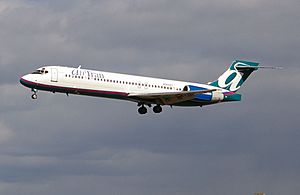
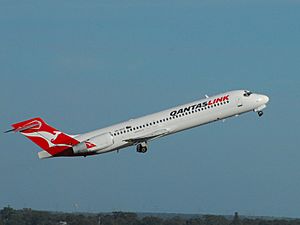
As of July 2012, 143 Boeing 717-200s were still being used by airlines. The main airlines using them were Southwest Airlines (88 planes), Hawaiian Airlines (18 planes), Cobham Aviation Services Australia (13 planes), Blue1 (9 planes), Volotea (9 planes), and Turkmenistan Airlines (6 planes). Delta Air Lines was set to receive 88 717s from Southwest Airlines in 2013.
Accidents and Safety
As of March 2009, the Boeing 717 has been involved in five accidents. Luckily, no one has died in any of these accidents. Also, there have been no "hull-loss" accidents. A hull-loss accident means the plane is so badly damaged it can't be fixed, or it's completely destroyed.
Quick Facts About the Boeing 717

| 717-200 Basic Gross Weight |
717-200 High Gross Weight |
|
|---|---|---|
| Cockpit crew | Two pilots | |
| Passengers, typical seating |
106 (two-class) 117 (one-class) |
|
| Length | 37.8 meters (124 ft 0 in) | |
| Wingspan | 28.47 meters (93 ft 5 in) | |
| Tail height | 8.92 meters (29 ft 1 in) | |
| Cabin width, external | 334.2 cm (131.6 in) | |
| Cabin width, internal | 314.5 cm (123.8 in) | |
| Max takeoff weight | 49,900 kg (110,000 lb) | 54,900 kg (121,000 lb) |
| Max range | 2,645 km (1,430 nmi) | 3,815 km (2,060 nmi) |
| Typical cruising speed | Mach 0.77 (811 km/h, 504 mph) at altitude of 10,400 m (34,100 ft) |
|
| Ceiling | 11,300 m (37,100 ft) maximum altitude 10,400 m (34,100 ft) typical altitude |
|
| Powerplants (2x) | Rolls Royce BR715-A1-30 | Rolls Royce BR715-C1-30 |
| Engine thrust | 82.3 kN (18,500 lbf) | 93.4 kN (21,000 lbf) |
Orders and Deliveries
Orders for the 717
| 2004 | 2003 | 2002 | 2001 | 2000 | 1999 | 1998 | 1997 | 1996 | 1995 |
|---|---|---|---|---|---|---|---|---|---|
| 8 | 8 | 32 | 3 | 21 | 0 | 50 | 0 | 0 | 50 |
Deliveries of the 717
| 2006 | 2005 | 2004 | 2003 | 2002 | 2001 | 2000 | 1999 | 1998 | 1997 |
|---|---|---|---|---|---|---|---|---|---|
| 5 | 13 | 12 | 12 | 20 | 49 | 32 | 12 | 0 | 0 |
Related Pages
- Similar aircraft
- Becher, Thomas. Douglas Twinjets, DC-9, MD-80, MD-90 and Boeing 717. The Crowood Press, 2002. ISBN: 1-86126-446-1.
| Boeing 7x7 aircraft timeline, 1955–now | ||||||||||||||||||||||||||||||||||||||||||||||||||||||||||
|---|---|---|---|---|---|---|---|---|---|---|---|---|---|---|---|---|---|---|---|---|---|---|---|---|---|---|---|---|---|---|---|---|---|---|---|---|---|---|---|---|---|---|---|---|---|---|---|---|---|---|---|---|---|---|---|---|---|---|
| 1950s | 1960s | 1970s | 1980s | 1990s | 2000s | 2010s | ||||||||||||||||||||||||||||||||||||||||||||||||||||
| 1955 | 1956 | 1957 | 1958 | 1959 | 1960 | 1961 | 1962 | 1963 | 1964 | 1965 | 1966 | 1967 | 1968 | 1969 | 1970 | 1971 | 1972 | 1973 | 1974 | 1975 | 1976 | 1977 | 1978 | 1979 | 1980 | 1981 | 1982 | 1983 | 1984 | 1985 | 1986 | 1987 | 1988 | 1989 | 1990 | 1991 | 1992 | 1993 | 1994 | 1995 | 1996 | 1997 | 1998 | 1999 | 2000 | 2001 | 2002 | 2003 | 2004 | 2005 | 2006 | 2007 | 2008 | 2009 | 2010 | 2011 | 2012 | 2013 |
| Boeing 707 | ||||||||||||||||||||||||||||||||||||||||||||||||||||||||||
| Boeing 717 (MD-95) | ||||||||||||||||||||||||||||||||||||||||||||||||||||||||||
| Boeing 727 | ||||||||||||||||||||||||||||||||||||||||||||||||||||||||||
| Boeing 737 | ||||||||||||||||||||||||||||||||||||||||||||||||||||||||||
| Boeing 747 | ||||||||||||||||||||||||||||||||||||||||||||||||||||||||||
| Boeing 757 | ||||||||||||||||||||||||||||||||||||||||||||||||||||||||||
| Boeing 767 | ||||||||||||||||||||||||||||||||||||||||||||||||||||||||||
| Boeing 777 | ||||||||||||||||||||||||||||||||||||||||||||||||||||||||||
| Boeing 787 | ||||||||||||||||||||||||||||||||||||||||||||||||||||||||||
| = Not being made anymore | = Still being made | |||||||||||||||||||||||||||||||||||||||||||||||||||||||||
Images for kids
-
The 717 has five seats in each row, like the DC-9.
-
The first 717 was given to AirTran Airways in September 1999, and the last one in May 2006.
-
Hawaiian Airlines uses the 717 for short flights between islands.
See also
 In Spanish: Boeing 717 para niños
In Spanish: Boeing 717 para niños


